

News
Tesla app hints at Dashcam live-streaming features, upgraded Boombox
Tesla seems set to release some key updates to its mobile app. Recent reports from the Tesla community revealed that the company is working on some new mobile features behind the scenes. These include dashcam live streaming features, as well as the capability to view dashcam clips remotely.
Tesla recently rolled out a new version of its iOS mobile app, aptly named V4.2.0. The update’s release notes indicate that the improvements have been made to iOS’ Tesla widgets. A look at posts from the EV community confirms that Tesla’s iOS widget is now larger. The updated widget features options for quick controls such as locking and unlocking the vehicle, access charging, opening the frunk, and locking/unlocking a car.
New Tesla app update available on iOS
Version: 4.2.0 🍀I see what you did! 👀 pic.twitter.com/lehwqKJfdh
— DatHandsomeJerk (@DatHandsomeJerk) October 14, 2021
More interestingly, however, were the hints that were present behind the scenes of the update. Tesla update tracker group @Teslascope noted that several upcoming features were also referenced in the iOS app. These include the ability to watch videos from a Tesla on a mobile device. Based on images in the mobile app, it appears that Tesla is looking to introduce the capability to view footage from specific cameras around its vehicles.
A first glimpse of the UI relating to the live-streaming of the Dashcam on the @Tesla mobile app. pic.twitter.com/TH1wqKpe0V
— Teslascope (@teslascope) October 14, 2021
But this is not all. The Tesla software update tracker group also noted that dashcam live-streaming functions are also referenced directly in the Tesla app. What’s more, there were also references pointing to drivers getting the ability to project their voice via the mobile app through their vehicles’ Pedestrian Warning Systems (PWS). This should make features like Sentry Mode even more effective, as it could very all add an element of surprise for those acting suspiciously around a Tesla.
Dashcam Live Streaming is now CONFIRMED in addition to viewing Dashcam clips!
You will also be able to speak directly via your mobile phone and project your voice via the PWS (Pedestrian Warning System). pic.twitter.com/g9DVRJVAB6
— Teslascope (@teslascope) October 14, 2021
Tesla has been working on its mobile app in recent months. Even before the recent updates, the company already rolled out a revamp of its mobile app, adding features like a fully revamped UI, a revised Summon page, and direct access to the Tesla Shop. These updates and improvements to the Tesla app could come in handy for the electric car maker, especially considering CEO Elon Musk’s plan of opening the Supercharger Network to non-Tesla EVs later this year.
When discussing how non-Tesla owners could access the Supercharger Network, Musk stated that everything could be done through the Tesla App. “We’re currently thinking it’s a real simple thing where you just download the Tesla app, and you go to Supercharger. And you just indicate which stall you’re in. So you plug in your car, even if it’s not Tesla. And then you just access the app and say, turn on this stall that I’m in for how much electricity. And this should basically work with I think almost any manufacturer’s cars,” Musk said.
Don’t hesitate to contact us with news tips. Just send a message to tips@teslarati.com to give us a heads up.

Elon Musk
Elon Musk and Tesla AI Director share insights after empty driver seat Robotaxi rides
The executives’ unoccupied tests hint at the rapid progress of Tesla’s unsupervised Robotaxi efforts.

Tesla CEO Elon Musk and AI Director Ashok Elluswamy celebrated Christmas Eve by sharing personal experiences with Robotaxi vehicles that had no safety monitor or occupant in the driver’s seat. Musk described the system’s “perfect driving” around Austin, while Elluswamy posted video from the back seat, calling it “an amazing experience.”
The executives’ unoccupied tests hint at the rapid progress of Tesla’s unsupervised Robotaxi efforts.
Elon and Ashok’s firsthand Robotaxi insights
Prior to Musk and the Tesla AI Director’s posts, sightings of unmanned Teslas navigating public roads were widely shared on social media. One such vehicle was spotted in Austin, Texas, which Elon Musk acknowleged by stating that “Testing is underway with no occupants in the car.”
Based on his Christmas Eve post, Musk seemed to have tested an unmanned Tesla himself. “A Tesla with no safety monitor in the car and me sitting in the passenger seat took me all around Austin on Sunday with perfect driving,” Musk wrote in his post.
Elluswamy responded with a 2-minute video showing himself in the rear of an unmanned Tesla. The video featured the vehicle’s empty front seats, as well as its smooth handling through real-world traffic. He captioned his video with the words, “It’s an amazing experience!”
Towards Unsupervised operations
During an xAI Hackathon earlier this month, Elon Musk mentioned that Tesla owed be removing Safety Monitors from its Robotaxis in Austin in just three weeks. “Unsupervised is pretty much solved at this point. So there will be Tesla Robotaxis operating in Austin with no one in them. Not even anyone in the passenger seat in about three weeks,” he said. Musk echoed similar estimates at the 2025 Annual Shareholder Meeting and the Q3 2025 earnings call.
Considering the insights that were posted Musk and Elluswamy, it does appear that Tesla is working hard towards operating its Robotaxis with no safety monitors. This is quite impressive considering that the service was launched just earlier this year.
Elon Musk
Starlink passes 9 million active customers just weeks after hitting 8 million
The milestone highlights the accelerating growth of Starlink, which has now been adding over 20,000 new users per day.

SpaceX’s Starlink satellite internet service has continued its rapid global expansion, surpassing 9 million active customers just weeks after crossing the 8 million mark.
The milestone highlights the accelerating growth of Starlink, which has now been adding over 20,000 new users per day.
9 million customers
In a post on X, SpaceX stated that Starlink now serves over 9 million active users across 155 countries, territories, and markets. The company reached 8 million customers in early November, meaning it added roughly 1 million subscribers in under seven weeks, or about 21,275 new users on average per day.
“Starlink is connecting more than 9M active customers with high-speed internet across 155 countries, territories, and many other markets,” Starlink wrote in a post on its official X account. SpaceX President Gwynne Shotwell also celebrated the milestone on X. “A huge thank you to all of our customers and congrats to the Starlink team for such an incredible product,” she wrote.
That growth rate reflects both rising demand for broadband in underserved regions and Starlink’s expanding satellite constellation, which now includes more than 9,000 low-Earth-orbit satellites designed to deliver high-speed, low-latency internet worldwide.
Starlink’s momentum
Starlink’s momentum has been building up. SpaceX reported 4.6 million Starlink customers in December 2024, followed by 7 million by August 2025, and 8 million customers in November. Independent data also suggests Starlink usage is rising sharply, with Cloudflare reporting that global web traffic from Starlink users more than doubled in 2025, as noted in an Insider report.
Starlink’s momentum is increasingly tied to SpaceX’s broader financial outlook. Elon Musk has said the satellite network is “by far” the company’s largest revenue driver, and reports suggest SpaceX may be positioning itself for an initial public offering as soon as next year, with valuations estimated as high as $1.5 trillion. Musk has also suggested in the past that Starlink could have its own IPO in the future.
News
NVIDIA Director of Robotics: Tesla FSD v14 is the first AI to pass the “Physical Turing Test”
After testing FSD v14, Fan stated that his experience with FSD felt magical at first, but it soon started to feel like a routine.

NVIDIA Director of Robotics Jim Fan has praised Tesla’s Full Self-Driving (Supervised) v14 as the first AI to pass what he described as a “Physical Turing Test.”
After testing FSD v14, Fan stated that his experience with FSD felt magical at first, but it soon started to feel like a routine. And just like smartphones today, removing it now would “actively hurt.”
Jim Fan’s hands-on FSD v14 impressions
Fan, a leading researcher in embodied AI who is currently solving Physical AI at NVIDIA and spearheading the company’s Project GR00T initiative, noted that he actually was late to the Tesla game. He was, however, one of the first to try out FSD v14.
“I was very late to own a Tesla but among the earliest to try out FSD v14. It’s perhaps the first time I experience an AI that passes the Physical Turing Test: after a long day at work, you press a button, lay back, and couldn’t tell if a neural net or a human drove you home,” Fan wrote in a post on X.
Fan added: “Despite knowing exactly how robot learning works, I still find it magical watching the steering wheel turn by itself. First it feels surreal, next it becomes routine. Then, like the smartphone, taking it away actively hurts. This is how humanity gets rewired and glued to god-like technologies.”
The Physical Turing Test
The original Turing Test was conceived by Alan Turing in 1950, and it was aimed at determining if a machine could exhibit behavior that is equivalent to or indistinguishable from a human. By focusing on text-based conversations, the original Turing Test set a high bar for natural language processing and machine learning.
This test has been passed by today’s large language models. However, the capability to converse in a humanlike manner is a completely different challenge from performing real-world problem-solving or physical interactions. Thus, Fan introduced the Physical Turing Test, which challenges AI systems to demonstrate intelligence through physical actions.
Based on Fan’s comments, Tesla has demonstrated these intelligent physical actions with FSD v14. Elon Musk agreed with the NVIDIA executive, stating in a post on X that with FSD v14, “you can sense the sentience maturing.” Musk also praised Tesla AI, calling it the best “real-world AI” today.








